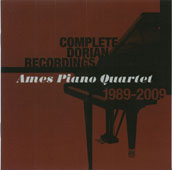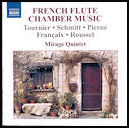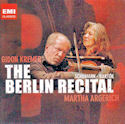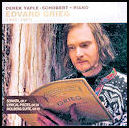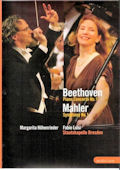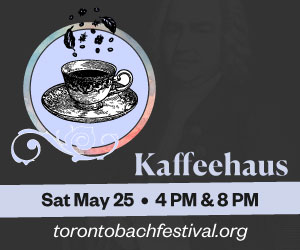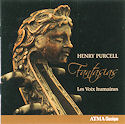 Purcell - Fantasias
Purcell - Fantasias
Les Voix Humaines
ATMA ACD2 2591
Henry Purcell composed his fifteen Fantasias and In nomines just after becoming the organist at Westminster Abbey. Composed for consorts of three to seven viols, they are remarkable in their contrapuntal fluidity and surprising in their occasional dissonance in even modern day terms. They are played with acuity and sensitivity here by the gifted Montreal viol ensemble, Les Voix Humaines, on historic instruments with a local connection.
Here's a bit of background on the instruments themselves. The Hart House Viols are one of so many hidden treasures lurking in the corners of Toronto buildings. Purchased by the Massey Foundation in 1929, Vincent Massey had the set of viols housed at U of T's Hart House and in 1935 they became the property of that illustrious institution. In 2008, in a stroke of musical brilliance, Susie Napper and Les Voix Humaines had the viols refurbished to playing condition for this wonderful release.
This winning combination of compositions, instruments and performers is breathtaking. Of note is Fantasia V in Bb major Z.736 for its twists of rhythm and tempo. In Fantasia IX in a minor Z.740 the aural colours are subtle and intriguing, especially in the slower sections. The treble viol holds middle C throughout the Fantasia upon one note in F major, Z. 745 creating a sonic foundation for the other viols to play around - a kind of early music forerunner of Terry Riley's In C.
Les Voix Humaines prove themselves yet again to be world class musicians. This is a very enjoyable musical experience.
Tiina Kiik
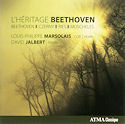
The Beethoven Heritage (Romantic music for horn)
Louis-Philippe Marsolais; David Jalbert
ATMA ACD2 2952
The French horn probably isn't the first instrument that springs to mind when you think of solo sonatas with keyboard accompaniment, but this fascinating CD features duo works from a pivotal period - both physically and musically - in that instrument's history.
The hand-stopped natural horn was gradually replaced by the valve horn from about 1813 on, and the works here reflect the changes that were occurring in the instrument's solo repertoire around the same time.
Beethoven wrote his Op.17 F major sonata for one of the greatest natural horn virtuosi, Giovanni Punto, in Vienna in 1800; it was a significant event, as sonatas were new ground for an instrument traditionally featured as a soloist only in concertos.
The three other composers represented here were all pianist friends of Beethoven. Ferdinand Ries' Sonata in F was inspired by an 1811 visit to Kassel, home of the horn virtuosi Schunk brothers; Carl Czerny's Andante e polacca for natural horn was probably written for Eugene Vivier's Vienna visit in 1848, Czerny having written a work for valve horn some 18 years earlier. Both of Ignaz Moscheles' works for horn and piano are here: the Introduction et Rondeau Ecossais from 1821; and the Rossini-inspired Thème varié of 1860.
Performing these works on a modern horn, Louis-Philippe Marsolais shows complete mastery of a notoriously difficult instrument, leaving nothing to be desired in his technical assuredness, dynamic range, tone quality and expressive nuance. Pianist David Jalbert provides outstanding support.
Terry Robbins
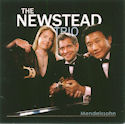
Mendelssohn - Piano Trios
Newstead Trio
Prince Productions Prince 9809 P
www.newsteadtrio.com
To date, the Newstead Trio has released five CDs, mostly for the small Prince label, based in Lancaster, Pennsylvania. Consisting of American violinist Michael Jamanis, Canadian cellist Sara Male and Chinese pianist Xun Pan, the group's recorded repertoire has ranged from Mozart to Piazzolla.
Just in time for Mendelssohn's 200th birthday, they've released a disc of the composer's two piano trios. This is well-trodden ground: the Beaux Arts, Florestan, Borodin and many other fine groups have recorded this repertoire - and in the face of such abundance the value of this recording is questionable. On the other hand, it can be argued that it's brave and admirable for a yet another ensemble to record such well known repertoire, as it invites comparison with the best.
With this in mind, I'm happy to say that with this new disc, the Newstead musicians have clearly demonstrated they can play this music as well as anyone. From the opening of the Op. 49 Trio in D Minor, it's apparent that they're at home with both the Classical and Romantic qualities that co-habit Mendelssohn's scores. Balance and ensemble are exemplary, and throughout the playing is marked by a strong sense of direction. Some of the most expressive playing on this disc can be heard in the second movement of the Op. 66 Trio in C Minor, which for some unfathomable reason remains the lesser known of these two works.
Unfortunately, there are a few flies in this ointment: a boomy murkiness in the bass, and also at times a glassy quality to Male's cello. Still, there's much to be admired - and the question of whether the world wants one more disc of the Mendelssohn trios will be answered soon enough by the CD-buying public.
Colin Eatock
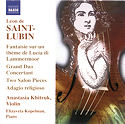 Leon de Saint-Lubin - Virtuoso Works for Violin, Vol.1
Leon de Saint-Lubin - Virtuoso Works for Violin, Vol.1
Anastasia Khitruk; Elizaveta Kopelman
Naxos 8.572019
Although born in Italy, the now-forgotten 19th century violin virtuoso and composer Leon de Saint-Lubin spent virtually all of his life in Austria and Germany, enjoying a highly successful career in Vienna and in Berlin, where he died at the age of 44 in 1850. His works mirror a period when German music was developing from the Classical to the Romantic style: there are echoes of Beethoven here, along with touches of Schubert, Mendelssohn and Spohr, and even hints of early Brahms.
It's difficult to make a definitive judgement from a few selected works - he also left unpublished operas, symphonies and concertos - but clearly Saint-Lubin was not only an outstanding violinist but also a more than competent composer, highly-regarded in his time and obviously capable of some excellent piano writing.
Khitruk is brilliant throughout this stunning CD, particularly in the unaccompanied Lucia di Lammermoor Fantaisie Op.46 and the Thalberg Theme and Etude transcription, and has a sympathetic partner in Kopelman in the duo selections.
A very few Saint-Lubin pieces have been recorded before, with mixed opinions regarding their merit, but nothing on this scale; I found it an absolute revelation.
The CD cover implies that this is only Volume 1, suggesting more to come; there are, apparently, five unpublished Saint-Lubin violin concertos - now there's a project!
Recorded in Newmarket and the CBC's Glenn Gould Studio by the usual Kraft & Silver team, the sound quality is exemplary.
Terry Robbins
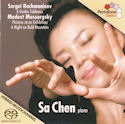 Rachmaninov - 6 Etudes;
Rachmaninov - 6 Etudes;![]()


